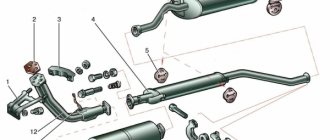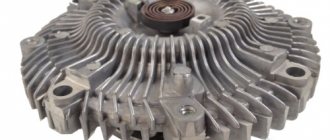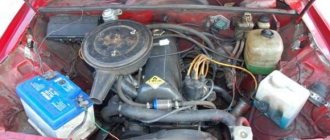There are fans of direct-flow exhaust, when a loud roar of the engine is heard. But there are also those who think about how to reduce the sound of the muffler. If you make a quiet muffler with your own hands, then the ride will be more comfortable, because the cabin will be quieter. Especially on domestic cars like the VAZ 2109, the question of how to make a silent muffler is relevant. If you can make a quiet muffler on the nine, then the car will bring more joy to its owner.
Ways to muffle the exhaust sound
Before tuning the exhaust system, you need to understand the reasons why the sound of the engine becomes louder over time. The operation of the engine itself is a fairly loud process, but the muffler and other components of the exhaust system perfectly suppress this loud noise. Without a muffler, the engine noise is very loud.
The noise occurs because the fuel mixture explodes in the combustion chamber, releasing gases that then exit into the exhaust pipe. We will not talk in detail about the operation of the engine, you can read about this in another article, but here we will talk specifically about how to muffle the exhaust sound.
The explosion releases energy that pushes the piston, and when the piston has moved the required distance, the exhaust valve opens, through which the exhaust gases exit and go further through the exhaust system. To effectively absorb noise, thick metal parts are used. So, the thicker the metal used in the exhaust system, the quieter the car will drive due to the fact that there will be less vibration.
The exhaust manifold is the first one to absorb the noise, which is why it is made so large and thick, so it best dampens the noise that comes from the cylinder block. Even if you compare the exhaust pipe of any more or less normal foreign car with the exhaust pipe of a domestic car, you can see that in foreign cars the pipe is heavier and thicker, which is why such a car runs quieter.
This is why when you drive an old VAZ 2114, the noise is such that you can’t hear what the passengers in the rear seats are saying, which is why you start thinking about how to muffle the exhaust sound.
The exhaust system also has a resonator, which is needed to reduce the speed of gases through the exhaust pipe. And after the resonator comes a muffler. When exhaust gases pass through the resonator, they lose some energy and continue to flow more slowly.
Gases lose the largest share of their energy in the muffler. If we consider a good muffler, then it contains several separate housings, after passing through which little remains of the noise.
Device functions
You need to understand that the exhaust system plays an irreplaceable role, so it should be given due attention.
Let's consider the main purpose of the muffler through its advantages:
- It serves to reduce the content of pollutants in exhaust gases;
- The exhaust gases make less noticeable noise;
- When performing all the above functions, the VAZ 2106 engine does not lose power.
Processes
Considering how the muffler works and is designed, we can distinguish three main processes:
- Distribution of gases throughout all tubes in the engine;
- Damping sound waves so that the noise becomes less pronounced;
- The predominance of shock waves in a medium that consists mainly of gaseous matter;
How to make the quietest muffler for a car yourself?
When the issue with noise during car operation has gone too far, and you have decided to make the quietest muffler for the car, then you need to start by preparing the tool. We will need:
- welding machine, an inverter or semi-automatic will do;
- angle grinder and discs for it;
- workbench with a vice.
The surest and most inexpensive way to make a muffler quieter is to weld in an additional resonator. This can be done in a garage yourself.
An additional resonator can be placed between the standard resonator and the muffler. You can install a ready-made resonator; you just need to weld it into the desired place in the pipe. Or you can assemble the resonator yourself. For those who doubt whether the exhaust will become quieter if an additional resonator is welded in, the answer is clear - the exhaust will become quieter. If everything is done correctly.
Resonator - what is it?
The resonator is the name given to the main muffler (usually it looks like the widest pipe in the VAZ exhaust system). The main task of this element is to promptly remove exhaust gases from the system to make room for new ones.
It is believed that the entire useful power of the motor depends on the quality of the resonator. Therefore, the resonator on the VAZ 2106 is located immediately behind the forward flow in order to absorb the main flow of hot gases.
Resonator Euro 3
With the development of the automotive industry, mufflers also developed. Thus, a EURO 3 class resonator for a VAZ is no different from EURO 2, however, to optimize engine performance, it has a special hole for installing a lambda probe. That is, the EURO 3 resonator is considered more functional and modern.
Thus, the muffler on the VAZ 2106 needs special attention from the driver. The design is extremely short-lived, so it is better to periodically drive the car into a pit and inspect all elements of the exhaust system than to end up on the road with a rotten pipe.
Source of the article: https://bumper.guru/klassicheskie-modeli-vaz/dvigatel/glushitel-vaz-2106.html
How to make an additional muffler resonator with your own hands
Making a muffler resonator with your own hands is quite simple; now we will discuss each step in detail. First you need to make an outer casing, it can be made from any steel pipe with thin walls: which looks like this:
The end part looks like this:
Then you need to take perforated iron with a thickness of 4.5 mm. This is enough to insert it into the end part, as in the photo below:
Next, you need to fill the resonator with something; ordinary tin sponges are perfect for this purpose.
Then you need to pull the resonator body onto these washcloths, as in the photo:
Then you need to take rivets and rivet the entire structure, so you don’t even need to weld it, like this:
For those who like to cook, you can also brew the end parts to the central part.
When everything is ready, you need to process the seams and you can paint them with heat-resistant paint, and after that the quietest muffler on your car is ready.
VAZ 2114/2115
There are no innovations in the VAZ 2114/2115 mufflers, the same 4 chambers and three partitions, three perforated pipes and one outlet pipe with an increased diameter.
As a rule, the metal of the outlet pipe rots, and that’s where the rattling noise comes from.
UAZ
Next, let's look at the muffler design using the UAZ Patriot as an example.
First comes the upper housing casing, under which there is a layer of fiberglass.
Inside there are three chambers, separated by two partitions, two perforated pipes without narrowed sections. There are no vibration-absorbing materials.
The inner diameter of the outlet pipe is 52 mm, the inlet pipe is 53 mm. The outer diameter of the inlet pipe is 57 mm, the outlet pipe is 55 mm. Body length 50 cm.
The UAZ Patriot muffler is no longer distinguished by anything special. It makes a lot of noise and rusts inside.
Possible inconveniences associated with a quiet muffler
The car will now be quieter, which is what we wanted to achieve, but there may be some disadvantages - an increase in the overall weight of the exhaust system. Therefore, it is necessary to hang stronger brackets so that the exhaust pipe does not come off on rough roads. There are also cases when rubber shock absorbers are hung. But in fact, a homemade resonator will weigh about 2-3 kg.
It is also necessary to test in action how the exhaust system works so that gases exit normally through the exhaust pipe. Therefore, it is necessary to check at higher speeds, then it will be possible to draw the right conclusions. But as a rule, gases will escape through such a resonator without difficulty.
And then in the video there is another way to reduce the sound of the muffler, making a really very quiet exhaust system:
Engine power is the factor that people pay attention to first when getting to know a car. And in the future they will never forget about her. In addition, many sometimes have a desire to increase it. And one of the ways to achieve this would be a direct-flow muffler or direct-flow muffler installed on a production car.
Muffler mount
Each element of the exhaust system is fixed to the bottom of the car in a different way. For example, the exhaust manifold is “tightly” screwed to the engine with powerful bolts to eliminate the possibility of gas leakage. But the “glushak” itself is attached to the bottom with special rubber hangers on hooks.
This method of fixation allows the muffler to resonate during operation without transmitting additional vibrations to the body and interior. The use of rubber hangers also makes it possible to conveniently remove the muffler if necessary.
The muffler is attached to the bottom of the car using suspensions, which create a reliable fixation and avoid unnecessary vibrations on the body
General information about the exhaust system (ES)
As you know, the muffler is part of the exhaust system, and it is necessary to remember about it before you begin to understand what forward flow is. It performs more tasks than it might seem at first glance. The very first and most obvious is the removal of vehicle exhaust gases. Another, no less important function of the aircraft will be to provide ventilation to the engine cylinders.
This is achieved in a rather original way - at the moment the valves of one cylinder are closed, a vacuum is created in the exhaust manifold, which moves through the system at the speed of sound. Having been reflected from obstacles, it returns to the manifold by the time the next valve opens, creating an area of reduced pressure at the outlet of the cylinder, thereby improving ventilation and purging of the internal volume.
The speed and time of movement of the vacuum depend on the length of the path (exhaust pipes) and engine speed, but this is taken into account when calculating the standard exhaust system. Well, another task will be to combat noise, which is what the muffler does on the car. In general, a traditional aircraft can be represented as shown in the picture.
Changing the exhaust pipe
The exhaust pipe (in common parlance it is called “pants”) on a VAZ 2106 car is attached to the exhaust manifold. Before starting the repair, it is necessary to disconnect the battery, since it is located quite close to the pipe, so the probability of shorting the wire going to the starter is very high. Complete removal of the battery from the car is not required - just disconnect the negative terminal. To work, you need an inspection hole, overpass or lift, since you will have to carry out some manipulations in the lower part of the car.
Replacing the exhaust pipe
The four nuts that secure the pipe to the exhaust manifold are secured with a flexible plate. It needs to be bent to release the edges of the nuts. Using a 13mm wrench (it is best to use a socket or socket), completely unscrew the nuts and inspect them for damage. If the threads are broken or the edges are worn out, it is better to replace the parts with new ones. Please note: simple steel nuts cannot be installed! They should be made of brass or bronze so that they do not stick to the studs. Now pull the pipe, then remove the gasket and clean the surface of dirt.
All elements of the exhaust system are exposed to high temperatures, so reusing the gasket is prohibited, as it will not be able to provide the required level of sealing. Now you need to get under the car and unscrew the bolt that secures the pipe to the gearbox. You will also see a clamp connecting the resonator to the exhaust pipe. Apply penetrating lubricant to the threaded connection on it to make it easier to unscrew the nuts. Give the grease time to soak in, then remove the nuts and move the clamp to the side, making room for repairs.
Using a hammer, gently tap the pipe at the joint, then try to separate it with your hands. Be careful not to cut yourself or hit your hands or head. After disconnecting, remove the old exhaust pipe and install a new one. Do not rush to completely tighten all threaded connections under the car. First you need to install a new gasket on the exhaust manifold studs. It is recommended to lubricate it on both sides with CV joint grease so that during operation it does not burn to the surface of the pipe or manifold. Then place the pipe and attach all four nuts. Tighten them carefully, crosswise, so as not to deform the gasket.
After final tightening, the nuts must be locked and installation of the clamp at the junction with the resonator can begin. Replacing a VAZ muffler and replacing the exhaust pipe are very similar, only they are carried out in different parts of the car.
To change the resonator, you will need to perform the same manipulations, only the clamps are removed at the same time, and the muffler and exhaust pipe remain in place. And you will have to tap two joints to remove the resonator. With the new exhaust system, the VAZ 2106 will run much quieter, and the engine will emit less harmful substances into the atmosphere.
Paying special attention to the engine, gearbox or suspension shock absorbers, car owners often forget to monitor seemingly insignificant units. One of these simple but very important elements is the exhaust system muffler. If you do not take timely measures to repair or replace it, you can deprive yourself of the ability to drive a car for a long time.
Direct-flow car muffler device
When tuning a car, a direct-flow muffler is often installed instead of the usual one. What is this connected with? The fact is that direct flow allows you to solve two problems:
- change the sound, making it bassy and growling, which creates the impression of a powerful, “charged” car, although in reality this may not be the case;
- slightly, by a few horsepower, increase the actual engine power, reducing losses to overcome the resistance to the movement of exhaust gases in the muffler.
Now that we have figured out what direct flow does, we can study its structure. You can compare what a direct-flow muffler (one of its possible options) and a standard one looks like in the figure below.
As you can see, the difference is that the direct-flow muffler has a simpler device. This simplification allows in many cases to make a homemade forward flow, especially for domestically produced cars, for example, the VAZ 2114.
How to make a direct-flow muffler with your own hands
Therefore, there is no need to fully describe, for example, the forward flow on the VAZ 2109 or the forward flow on the VAZ 2106; it is enough to give the general principle according to which such a device is created. Usually, when considering how to make a forward flow with your own hands, a regular muffler is used as a blank, especially if you are making a forward flow for a VAZ or for some similar car (for example, VAZ 2114).
The standard muffler is removed from it, and then it is opened using a grinder, and all internal partitions and pipes are removed. The result is a direct-flow muffler blank, as shown in the photo.
But then, when you make a direct flow with your own hands, creativity begins. Although in this case we cannot talk about real forward flow. The fact is that for the most part we are talking about a forward flow muffler.
There are a variety of options for its implementation. Some people weld one pipe between the ends, some two, and some create several compartments and additionally use asbestos, basalt wool, and metal shavings to reduce the noise of a car engine. Various examples showing how to make a forward flow are shown in the photo below.
Moreover, the above options do not exhaust the methods by which such a device is made. To complete the work, it is necessary to weld the cut hole, and the forward flow for the car can be considered ready.
OKA car
The Lada OKA muffler is located perpendicular to the car body.
Inside the device there are three chambers and two partitions, three perforated pipes. No special innovations were introduced into the design of the product, so the principle of operation remains unchanged.
Additional Information
The desired result was achieved thanks to a whole range of measures affecting literally all elements of the car: the camshaft, combustion chambers, inlet and outlet manifolds, gas exhaust paths (their shape, length and location) and mufflers. And the solid, bass sound of the running engine was only a concomitant factor of the real direct-flow exhaust system. In fact, the purpose of creating such a device was to maximize the use of engine power and reduce its losses during engine operation.
And they achieved this, as already mentioned, with a whole set of measures that are impossible for an ordinary user to implement in a garage. So there is no need to create illusions that by acquiring a muffler that is in some way different from the standard one, you have significantly increased engine power and improved the dynamics of the car. The result of all such work will be, at best, a change in the sound of its exhaust. Although if this is your goal, then you will achieve the desired result.
Choosing a resonator for VAZ 2107
Four types of resonators are installed on the VAZ 2107:
- Long section with one tank. Installed on all classic carburetor VAZ 2101-2107 with an engine capacity of no more than 1.3 liters. Catalog number - 2101–1202005.
The last two types of resonators are shortened due to the addition of an additional element - a catalytic converter. Parts for Euro 2 and 3 differ in length (spare parts for Euro 3 are shorter) and the number of mounting bolts on the flange. The second tank is missing - its functions are performed by the catalyst.
The choice of resonator depends on the specific modification of the VAZ 2107. When purchasing, you need to keep in mind the following recommendations:
- On the carburetor version with a 1.3 liter engine, you can easily install a long section with one (VAZ 2101-07) or two (VAZ 2106-07) tanks. In the second case, the sound of the running engine will become quieter, but the power will drop by about 3-5 hp. With. Shortened resonators will not work.
- Both long resonators are suitable for carburetor and injection VAZ 2107, corresponding to Euro 0. When installing a part with one tank, the exhaust noise will increase and the engine power will increase slightly. Short pipes cannot be installed.
- The exhaust system for Euro 2 is equipped not only with a catalyst, but also with an oxygen sensor (lambda probe) mounted in the exhaust pipe. For such cars, the original shortened resonator with a two-bolt flange or any long section is suitable. However, such a resonator is not suitable for the VAZ 2107 Euro - it is connected to another catalyst and differs in length.
- The exhaust system of the VAZ 2107, manufactured in accordance with Euro 3 standards, has two oxygen sensors. On the VAZ 21074 you can install the original short resonator or a long one, but with some modifications.
Types of mufflers and their differences
There are 4 types of mufflers based on the method of absorbing acoustic waves:
- reflective;
- restrictive;
- absorption;
- resonator.
The reflective circuit is reverse-flow, the rest are direct-flow.
Reflective
If one muffler is installed in a car, then a reflective version is used. It uses the principle of “breaking” the flow of exhaust gases by creating several partitions, expansion chambers and turns. Exhaust volume is reduced to standard levels. For this reason, the vast majority of factory vehicles are equipped with the reflective type.
most popular for factory vehicle configuration
The disadvantage of this type of muffler is the reduction in engine power due to the resistance of the exhaust system to the flow of exhaust gases.
Resonator
A resonator muffler is installed as the first stage in the exhaust system of powerful engines. It consists of a perforated pipe placed in a housing. The body is divided into two or three sections. The energy of the exhaust gases is weakened due to a stepwise reduction in pressure.
installed as the first stage of exhaust energy suppression
The part reduces the force of sound vibrations and maintains engine power with a free flow of exhaust gases.
Restrictive
In restrictive mufflers, the gas flow passes through a diaphragm or cone narrowing, which leads to a decrease in engine power. The acoustic protection of such devices is low, since the diaphragm does not interfere with the rectilinear movement of the sound wave.
Absorption
The damping function for sound vibrations in the absorption muffler is performed by a finely porous non-flammable material located in the space between the perforated pipe and the housing. The design is similar to the resonator type. This type has little effect on power reduction.
↑ Design of the VAZ 2106 exhaust system
1 – exhaust pipe; 2 – exhaust pipe suspension cushion; 3 – muffler suspension belt; 4 – main muffler; 5 – front pipe of the main muffler; 6 – clamps; 7 – additional muffler; 8 – front pipe of additional muffler; 9 – clamp for fastening the exhaust pipe to the gearbox; 10 – gas receiver; 11 – intake pipes; 12 – blind partition; 13 – upper half-body of the additional muffler; 14 – front perforated pipe; 15 – lower half-body of the additional muffler; 16 – diaphragm; 17 – rear perforated pipe; 18 – upper half-body of the main muffler; 19 – inlet pipe; 20 – lower half-body of the main muffler; 21 – perforation on pipes to extinguish gas energy; 22 – perforated partition; 23 – left pipe; 24 – exhaust pipe; A, B – diagrams of the passage of exhaust gases through the additional and main mufflers, respectively.
The exhaust system consists of three separate sections. Exhaust gases from the exhaust manifold enter the exhaust pipe, then pass through the additional and main mufflers and exit into the atmosphere. The muffler pipes are connected to each other with clamps.
The intake pipe flange is secured with four brass nuts to the manifold studs through a reinforced asbestos gasket.
The main muffler is attached to the bottom of the trunk by two rubber straps and a rubber cushion. The mufflers are non-separable and cannot be repaired.
Replacing a return flow muffler with a direct flow one with your own hands
When manufacturing a direct flow, it is advisable to use the positive properties of several types of structures.
Reasons for replacing a standard muffler with a direct-flow muffler
Car owners change the factory muffler to a direct flow one for several reasons:
- obtaining an increase in engine power;
- subjective improvement of acoustic parameters of the exhaust;
- increasing the aesthetic parameters of the car;
- complete modernization of the exhaust channel;
- The installed muffler has failed.
Tools and materials for work
A direct-flow muffler is often purchased, but for lovers of tools and an insatiable thirst for creativity, we recommend making it yourself. It is preferable to make parts from stainless steel with a thickness of 0.8–2.0 mm. Select ferrous metal blanks with a thickness of 1.0–1.5 mm for the case, the rest 2.0–4.0 mm to avoid premature burnout of parts, and also use standard blanks. For the body, use a suitable size: a fire extinguisher, a thermos, an empty gas or scuba cylinder.
To fill the muffler chamber, non-flammable porous material or a combination of them is used:
- basalt or other mineral wool;
- fine mesh metal mesh;
- metal mesh for the kitchen;
- metal shavings.
- angle grinder (grinder);
- drill or drilling machine;
- welding machine;
- consumables: metal discs for grinders, drills, electrodes, etc.
Reworking an old muffler
- We dismantle the old muffler, disassemble it using a grinder, leaving the body parts and the inlet pipe. While preserving the partitions, we drill holes in them for the passage of exhaust gases. The cameras further reduce exhaust volume.
We cut out everything that is not needed from the old muffler
We perforate the inner pipe in an accessible way. The diameter of the perforated pipe is equal to the diameter of the inlet pipe or more up to 30%.
a small number of small holes will help preserve the rich bass rumble from the engine when exhausting
Keep in mind that mineral wool fibers will be “blown out” of the chamber faster through large holes and grooves.
Stainless steel helps to increase the service life of parts and mechanisms several times
In the future, the diameter of the inner pipe can be reduced by simple manipulations, but increasing it is disproportionately more difficult.
cut the length of the pipe to the required size
We put metal mesh for the kitchen in place of the perforation of the pipe.
cover the internal perforation with fine-porous non-flammable material
Wrap the kitchen mesh tightly with metal mesh in 1-3 layers. We fix the mesh with annealed steel wire with multiple twists or crimp it with several clamps.
We enhance perforation, reducing its permeability to mineral wool
We coordinate and clean the welding points, weld the perforated pipe into its regular place.
We carry out welding in compliance with all safety rules
We fill all free space inside the muffler tightly with the selected filler.
the presence of several chambers contributes to greater functionality of the muffler
Working with mineral wool requires personal protective equipment.
Manufacturers of resonators for VAZ 2107
In the post-Soviet space you can purchase resonators from many manufacturers. The production devices in greatest demand are:
- OJSC AvtoVAZagregat (manufacturer of original parts);
- OJSC Togliatti Plant of Technological Equipment;
- LLC "Izhora Silencer";
- TRANSMASTER UNIVERSAL (manufacturer of exhaust systems made of regular and stainless steel).
There are no big differences between the products of these brands. The service life of resonators made of refractory steel is approximately the same and amounts to 20-30 thousand kilometers. The service life of stainless steel products is approximately twice as long, but the price is one and a half times higher than the price of analogues made of ferrous metal.
How to make forward flow quieter
To reduce exhaust volume, devices are used that reduce the flow area of the exhaust pipe of the muffler. Let's look at the damper and flute commonly used on cars.
Damper installation
The damper is installed either before or after the muffler. The volume of the forward exhaust will be clearly reduced only when the damper is completely closed. Technological clearances of 3-5% remain for the passage of exhaust gases - so the engine does not stall. In this regard, engine power is significantly reduced due to blockage of the exhaust system.
the damper is made by hand
A damper is also used to switch from a direct-flow to a return-flow muffler and vice versa, if necessary. In this case, a new muffler is installed parallel to the old one, and the damper is mounted in front of them. This scheme is already used on some brands of cars from the factory.
mechanical adjustment of the damper is carried out on the move by the driver from the cab
You can drive a short distance with the throttle closed, but driving constantly is unacceptable for the engine.
the damper is installed in front of the muffler
Making and installing a flute
The flute (silencer) has more preferable characteristics. It dampens the exhaust pipe clearance much less than a damper. You can buy a flute, knowing the internal diameter of the outlet pipe, or make it yourself. Various silencer designs are shown in the photo.
Flute mounting options
Possible versions of the flute.
- External - for outlet pipe diameters up to 50–60 mm.
method of attaching a flute to a small diameter exhaust pipe
a properly designed flute “helps” you ride more quietly
the sound becomes “more pleasant” to the ears of the traffic inspector
Tools and materials for making a flute
- Bulgarian;
- electric drill;
- welding machine;
- spanners.
It is better to choose blanks from stainless steel with a thickness of 0.8–1.2 mm, which guarantees long service life. Blanks made of “ferrous” metals are acceptable with a thickness of 2.0–2.5 mm or less if we plan to use the flute for short periods. As blanks we use two pieces of pipe and sheet metal for the flange.
Making a flute with your own hands
The order of work performed:
- We adjust all parts to the required dimensions. We measure the dimensions of the flange and larger pipe “on site”.
- We drill holes.
the notch divides the gas exhaust into two streams, which reduces the exhaust volume
To further relieve the exhaust system from excess exhaust gas pressure, holes are drilled in the flange.
additional holes allow for a freer exhaust
the flow of exhaust gases is suppressed due to unloading holes and counterflow
There is no need to paint stainless steel
Videos about the flute
Video: sound of exhaust through forward flow without flute
Video: sound of a flute on the same car
Effect on the engine
Muffler VAZ 2106
As you know, engine power is directly proportional to the torque and speed of rotation of the crankshaft and is calculated by multiplying them. In this case, how quickly the crankshaft rotates depends on the filling of the cylinder with the fuel-air mixture. As a result, it becomes possible to influence the rotation of the shaft with the help of successful gas distribution. And if the muffler is plugged with something (for example, potatoes), then the pressure here will not decrease, which will make clearing it of gases almost impossible. This, in turn, will increase the pressure in the manifold, so the cylinder cannot be cleaned when the exhaust valve opens.
Because of this, a large amount of exhaust gases will remain here, which will prevent the cylinder from filling with a new mixture. This will cause the device to not be able to rotate at the same speed. Therefore, glitches will appear during its operation.
In the VAZ 2106 car, the special design of the muffler ensures that the amount of exhaust gases is well compatible with the content of the fresh mixture entering here. Therefore, the functions of the exhaust system are performed as efficiently as possible.
However, such a device does not increase power, so the amount of horsepower in the VAZ 2106 is quite low. In this case, you can perform engine tuning, which will help increase its power. Thus, the exhaust system affects the operation of the engine, but even if it is in perfect condition, the engine power does not increase.
Noise standards and liability for exceeding them
Responsibility for loud exhaust from a muffler is provided for under Article 8.23 of the Code of Administrative Offenses. The driver is charged for operating a vehicle with excess noise levels in accordance with the Technical Regulations of the Customs Union 018/2011 “On the safety of wheeled vehicles”, paragraph 9.9.
Table: dependence of the maximum permissible sound level on the vehicle category
| Vehicle category | Sound level (in decibels) |
| M1, N1, L | 96 |
| M2, N2 | 98 |
| M3, N3 | 100 |
Category M1, N1 and L are passenger cars with no more than 8 seats, trucks with a permissible maximum weight of no more than 3.5 tons, motorcycles/mopeds/ATVs. Category M2 and N2 are cars with more than 8 seats (except for the driver), but whose maximum weight does not exceed 5 tons, and trucks with a permissible maximum weight from 3.5 to 12 tons, respectively. Category M3 and N3 are full-fledged buses and trucks with a permissible maximum weight of more than 12 tons (trucks, most dump trucks).
According to 12.5.1 of the Code of Administrative Offenses, the driver (or owner) is charged for making changes to the design of the car without the permission of the supervisory authority - the traffic police.
So, the fine for a straight-through muffler can be either a warning plus a fine of 500 rubles, or two fines of 500 rubles each (in practice, two warnings cannot be issued).
The manufacture of a direct-flow muffler and its further improvement is within the power of most car enthusiasts. Despite the restrictions on the operation of such devices in our society, there are more and more people who want to make their own and install a direct-flow muffler on a car. Thanks to detailed instructions with photographs and videos, it will be much easier to make a forward flow.
Resonator malfunctions and repairs
Resonator malfunctions include:
- pipe beating on protruding parts of the body and other elements;
- burnout of the end part of the tank at the welding site of the body and pipe;
- burnout of the housing or internal perforated channel;
- exhaust gases exit through the mounting joints.
An annoying knock coming from under the car's bottom is usually the result of a loose exhaust pipe beating against the body and other components. The reason for this is the rubber fasteners, which wear out and stretch over time and cannot provide rigid fixation of the exhaust tract when moving. The problem is solved by replacing these fasteners.
Typically, exhaust tract hangers last much less than the pipe itself. Check the condition of the rubber bands at intervals of 10 thousand km; if cracks are found, immediately install new suspension mounts.
Other problems can be resolved in the following ways:
- The burnout on the side of the resonator can be welded. There is no need to remove the pipe to do this. An experienced welder will do the work on site, covering the body with a sheet of asbestos.
- If exhaust gases are observed escaping through the joints of the exhaust system, the mounting clamp or flange should be tightened further. You can also loosen the fastening, fit the parts closer together and re-tighten the clamp.
- If the housing or internal channel burns out, the resonator is usually replaced with a new one. If the fistula is small, you can try to weld it without removing it from the car.
Car enthusiasts with experience in welding can make a resonator tank with their own hands. To do this you should:
- Remove the resonator from the car.
- Carefully cut the body with a grinder.
- Take all dimensions (channel and hole diameters, body dimensions).
- Make a new tank according to the measurements taken.
- Weld old pipes to the new tank.
- Install a new resonator on the car.











